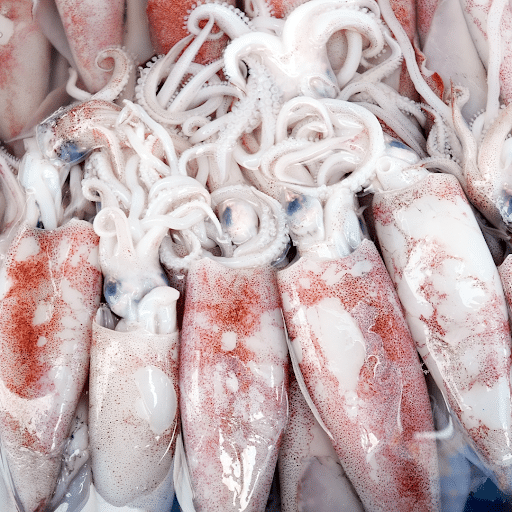As a Rhode Islander, I eat a lot of squid. It’s an item on most restaurant menus, typically as Rhode Island calamari.
Rhode Island, often referred to as the “squid capital of the world,” is a major hub for squid fishing, contributing to 54% of the squid landings in the Northeast. This dish, typically served breaded and fried with hot peppers and garlic butter, reflects Rhode Island’s historical ties to Italian culinary traditions and its prominent seafood industry.
But calamari isn’t just popular in New England. It’s a beloved delicacy in many cuisines around the world.
And it all starts with one key ingredient: fresh squid.
Preparing squid can seem daunting at first, but with the right techniques and a little time, you can turn a whole fresh squid into a delicious meal.
Today I’m sharing my comprehensive guide to cleaning and preparing squid for calamari, as well as some essential health and sourcing tips.
Cuisines Featuring Calamari
Calamari is a staple in Mediterranean cuisine, notably in Greek and Italian dishes, where it is often served fried with a squeeze of lemon. In Asian cuisine, particularly in Japanese and Korean, squid is used in stir-fries and as sashimi.
The adaptability of squid allows it to be incorporated into countless recipes, showcasing its global culinary appeal. These regional preparations highlight the versatility of squid and its ability to reflect local flavors and traditions, making it a beloved ingredient in diverse culinary cultures.

Tips for Buying and Storing Squid
When shopping for squid, freshness is key. Look for whole fresh squid with clear, bright eyes and firm, shiny skin. The flesh should smell fresh and mildly like the sea; any strong fishy odor is a sign of aging. Avoid any squid with a pungent smell or slimy texture.
Fresh squid is often available at specialty seafood markets and in the seafood section of well-stocked grocery stores. If fresh squid isn’t available, frozen is a viable alternative, often cleaned and ready to cook, which can save time.
Once home, if not using immediately, store squid in the coldest part of your refrigerator and use within two days for optimal freshness. For longer storage, squid can be frozen in a freezer-safe container or bag.
When freezing, lay the squid flat in a single layer to freeze evenly and prevent ice crystals from forming, which can affect the texture upon defrosting. Always thaw squid in the refrigerator overnight rather than at room temperature to ensure it remains at a safe temperature.
Tools and Equipment Needed
To clean squid efficiently, you’ll need a few basic tools:
- Sharp knife: Essential for making precise cuts.
- Cutting board: Opt for one that doesn’t absorb odors and avoids staining from the ink sack.
- Large bowls: Useful for holding clean squid and discarding parts not needed.
- Kitchen paper towels: Helps in drying the squid after washing.
- Disposable gloves: Optional but helpful to keep your hands clean and free from smells.

Cleaning and Preparing the Squid
- Removing the Head and Innards: Gently pull the head of the squid away from the body. This will bring out the innards and the clear quill (a plastic-like shard) inside the body cavity. Cut just below the eyes to keep the tentacles intact; discard the head and innards.
- Extracting the Beak: Find the small, hard beak at the base of the tentacles and remove it. It’s usually located at the center of the tentacles.
- Peeling the Skin: Remove the outer skin (thin and purple membrane) from the body of the squid. This can be done by pulling it away starting from the cut end of the body. Rinse the body under cold running water to remove any remaining skin and residue.
- Cleaning the Interior: Open up the body of the squid and scrape out any remaining internal organs and the ink sack, if still intact. Be careful if you want to keep the ink sack for recipes like squid ink pasta.
- Cutting into Rings: Lay the cleaned body on a cutting board and slice it crosswise to create even calamari rings. If you’re planning to cook them on high heat, keep the rings not too thin to avoid overcooking.
- Rinsing and Drying: Once cut, give the squid rings and tentacles another quick wash in cold water and pat them dry with kitchen paper towels.
Health Benefits of Calamari
Calamari is not only delicious but also offers several health benefits. It is low in calories and rich in protein, making it a great choice for those looking to maintain or lose weight. Squid is also packed with nutrients like vitamin B-12, potassium, iron, and phosphorus.
It’s an excellent source of vitamin B-12, which is crucial for maintaining healthy nerve cells and producing DNA, as well as helping to prevent anemia. The potassium content in calamari helps regulate blood pressure and prevents negative effects on the cardiovascular system.
Iron, which is abundant in calamari, is vital for making hemoglobin, the protein in red blood cells that carries oxygen throughout the body. Phosphorus contributes to the formation of bones and teeth and helps the body make ATP, a molecule that provides energy to our cells.

Pairing Suggestions for Calamari
Calamari, with its subtle seafood flavor and crispy texture when fried, pairs wonderfully with a variety of accompaniments. For a classic touch, serve it with a wedge of lemon and a simple tartar or marinara sauce. To elevate the experience, try aioli with herbs or a spicy remoulade that complements the squid’s light flavor.
On the side, a fresh arugula salad dressed with a lemon vinaigrette or a serving of zesty coleslaw can balance the richness of fried calamari.
Wine Pairings for Calamari Dishes
Pairing wine with calamari can enhance the dining experience by complementing its delicate flavors. For fried calamari, a crisp and acidic white wine like Sauvignon Blanc or a sparkling Prosecco works beautifully, cutting through the richness of the dish and refreshing the palate.
If you prefer grilled or sautéed calamari, consider a light-bodied white wine such as Pinot Grigio or Albariño. These wines pair well with the subtle sweetness of the squid and highlight its seafood characteristics without overwhelming it. For a more adventurous pairing, a dry rosé can also balance the flavors with its crispness and slight fruity notes.
Storing Squid
If not using the squid immediately, store it in a freezer-safe or airtight container in the fridge. It is best used within the next day to maintain its freshness and quality. For longer storage, squid can be frozen and defrosted in the fridge a day before use.
Cleaning and preparing squid might look complex at first glance, but it’s actually straightforward once you know the steps. Whether you’re making pepper squid, calamari rings, or any other squid dish, starting with a properly cleaned squid is crucial. Embrace this process and you’ll open up a whole new world of delicious seafood dishes to enjoy and share.










